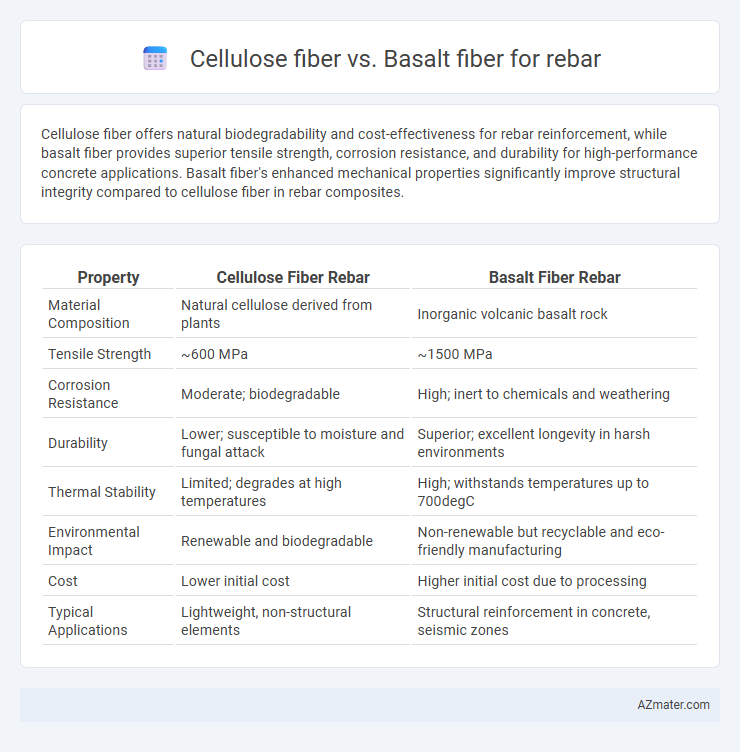Cellulose fiber offers natural biodegradability and cost-effectiveness for rebar reinforcement, while basalt fiber provides superior tensile strength, corrosion resistance, and durability for high-performance concrete applications. Basalt fiber's enhanced mechanical properties significantly improve structural integrity compared to cellulose fiber in rebar composites.
Table of Comparison
| Property | Cellulose Fiber Rebar | Basalt Fiber Rebar |
|---|---|---|
| Material Composition | Natural cellulose derived from plants | Inorganic volcanic basalt rock |
| Tensile Strength | ~600 MPa | ~1500 MPa |
| Corrosion Resistance | Moderate; biodegradable | High; inert to chemicals and weathering |
| Durability | Lower; susceptible to moisture and fungal attack | Superior; excellent longevity in harsh environments |
| Thermal Stability | Limited; degrades at high temperatures | High; withstands temperatures up to 700degC |
| Environmental Impact | Renewable and biodegradable | Non-renewable but recyclable and eco-friendly manufacturing |
| Cost | Lower initial cost | Higher initial cost due to processing |
| Typical Applications | Lightweight, non-structural elements | Structural reinforcement in concrete, seismic zones |
Introduction to Cellulose Fiber and Basalt Fiber
Cellulose fiber, derived from natural plant sources such as wood pulp, cotton, or hemp, offers renewable and biodegradable reinforcement for rebar applications, enhancing crack resistance and durability in concrete structures. Basalt fiber, produced from volcanic rock through melting and extrusion, provides exceptional tensile strength, chemical resistance, and thermal stability, making it a superior alternative to traditional steel reinforcement. Both fibers improve concrete reinforcement performance but differ significantly in composition, mechanical properties, and environmental impact.
Composition and Source of Cellulose Fiber
Cellulose fiber used in rebar is primarily composed of natural polymers derived from plant cell walls, predominantly cellulose, hemicellulose, and lignin, sourced from renewable materials like wood pulp, cotton, and hemp. Basalt fiber consists mainly of fine fibers extruded from molten basalt rock, rich in silica, alumina, and iron oxide, mined from volcanic rock deposits. The natural, biodegradable composition of cellulose fiber contrasts with the mineral-based, high-temperature resilient properties of basalt fiber, influencing their respective durability and environmental impact in reinforcement applications.
Composition and Source of Basalt Fiber
Basalt fiber, derived from natural volcanic basalt rock, consists primarily of silicates and oxides such as silicon dioxide, aluminum oxide, and iron oxide, offering superior thermal and mechanical performance compared to cellulose fiber, which is composed of natural plant-based cellulose polymers. Basalt fiber's inorganic mineral origin provides higher tensile strength, corrosion resistance, and durability in rebar applications, unlike cellulose fiber that has lower mechanical stability and biodegrades over time. The abundance and sustainable extraction of basalt rock in nature also contribute to its cost-effectiveness and environmental advantage as a composite reinforcement material for concrete structures.
Mechanical Properties Comparison
Cellulose fiber reinforced rebar exhibits moderate tensile strength and good flexibility, making it suitable for lightweight construction applications with enhanced crack resistance. Basalt fiber rebar demonstrates superior tensile strength, high modulus of elasticity, and excellent corrosion resistance, providing enhanced load-bearing capacity and durability in harsh environments. Mechanical properties comparison highlights basalt fiber's advantage in strength and stiffness, while cellulose fiber offers improved toughness and reduced brittleness in reinforced concrete structures.
Durability and Corrosion Resistance
Cellulose fiber rebar offers moderate durability but is prone to biodegradation and moisture absorption, which can compromise its structural integrity over time. Basalt fiber rebar demonstrates superior durability due to its high resistance to chemical attack, UV exposure, and thermal degradation. In terms of corrosion resistance, basalt fiber rebar significantly outperforms cellulose fiber, as it is non-corrosive and maintains performance in aggressive environments including saltwater and alkaline conditions.
Environmental Impact and Sustainability
Cellulose fiber rebar offers significant environmental benefits due to its renewable source and biodegradability, reducing landfill waste and carbon footprint during production. Basalt fiber rebar, derived from volcanic rock, presents a sustainable option with low energy processing requirements and extraordinary durability, extending the lifespan of concrete structures and minimizing material replacement. Both materials significantly improve sustainability in construction, with cellulose fibers excelling in renewability and basalt fibers in longevity and reduced environmental degradation.
Cost Analysis: Cellulose vs Basalt Fiber
Cellulose fiber rebar offers significant cost advantages due to its lower raw material and production expenses compared to basalt fiber, making it more suitable for budget-sensitive construction projects. Basalt fiber rebar, while costlier, provides superior tensile strength and durability, which can reduce long-term maintenance expenses. Evaluating total lifecycle costs, cellulose fiber rebar often emerges as a cost-effective alternative for non-structural applications, whereas basalt fiber justifies its premium price in high-performance structural environments.
Applications in Rebar Reinforcement
Cellulose fiber and basalt fiber both enhance rebar reinforcement, but basalt fiber offers superior tensile strength and corrosion resistance, making it ideal for high-performance concrete structures and infrastructure exposed to harsh environments. Cellulose fiber improves workability and provides crack control in concrete, suitable for low to medium load-bearing applications where cost efficiency is prioritized. Basalt fiber reinforced rebar is extensively used in bridge decks, marine structures, and seismic zones due to its durability and longevity compared to cellulose fiber reinforced counterparts.
Installation Process and Handling
Cellulose fiber rebar offers easier cutting and bending capabilities due to its lightweight and flexible nature, reducing labor and time during installation. Basalt fiber rebar requires special cutting tools and careful handling to prevent fiber damage, increasing preparation time and safety precautions. Both materials are corrosion-resistant, but cellulose fiber's compatibility with standard tools enhances overall efficiency on-site compared to the more rigid basalt fiber rebar.
Summary: Choosing the Optimal Fiber for Rebar
Cellulose fiber offers high flexibility and cost-effectiveness for rebar reinforcement but lacks the durability and strength of basalt fiber, which provides superior tensile strength, corrosion resistance, and thermal stability. Basalt fiber's enhanced performance in harsh environments makes it ideal for long-lasting infrastructure projects requiring sustained load-bearing capacity. Selecting between cellulose and basalt fibers depends on project-specific factors like budget constraints, environmental exposure, and structural demands.

Infographic: Cellulose fiber vs Basalt fiber for Rebar
 azmater.com
azmater.com